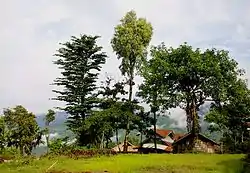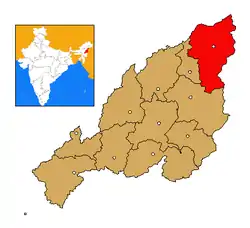Mon district
Mon (Pron:/mɒn/) is a district of Nagaland, a state in India.
Mon district | |
|---|---|
District | |
 Shangnyu Village, Mon district, Nagaland | |
 Mon district's location in Nagaland | |
| Coordinates: 26°43′N 95°02′E | |
| State | Nagaland |
| Country | India |
| Seat | Mon |
| Population (2011) | |
| • Total | 250,260 |
| Time zone | UTC+05:30 (IST) |
| ISO 3166 code | IN-NL-MN |
| Website | http://mon.nic.in/ |
Geography
Mon district is the northernmost district of Nagaland. It is surrounded by the state of Arunachal Pradesh to its north, Assam to its west, Myanmar to its east, Longleng district to its south-west and Tuensang district to its south. The town of Mon is its district headquarters.
Economy
In 2006 the Ministry of Panchayati Raj named Mon one of the country's 250 most backward districts (out of a total of 640).[1] It is one of the three districts in Nagaland currently receiving funds from the Backward Regions Grant Fund Programme (BRGF).[1]
Demographics
According to the 2011 census Mon district has a population of 250,260,[2] roughly equal to the nation of Vanuatu.[3] Mon has a sex ratio of 899 females for every 1000 males,[2] and an average literacy rate of 56.99%.[2]
Culture
Mon district is the home of the Konyak Nagas. The Konyaks are famous for their tattooed faces and bodies.[4] The most colourful festival of the Konyaks, Aoling (Aoleng), is observed during the first week of April every year.
Konyaks are the largest tribe among the Nagas. They speak the Konyak Language, a Sino-Tibetan language, with each village having their local dialect. The Konyaks were the last practising headhunters among the Nagas which continued into the 1960s.[5] The tribe embraced Christianity during the late 20th and early 21st century. Konyaks decorate their houses with skulls, hornbill beaks, elephant tusks, horns and wooden statues.
Konyaks are ruled by hereditary chiefs known as Anghs, and the institution of Anghship is still prevalent among the Konyaks. Every village has an Angh. Some of the smaller villages are ruled over by neighbouring village Anghs. The Angh's house is always the largest in the village, with a display of skulls in the front as a testament to his capability as a leader. Anghs still rule over the villages of Chui, Mon, Shangnyu, Tangnyu, Sheanghah Chingnyu, Wakching and Yannu.
Konyaks are adept artisans and skilled craftsmen. They make excellent wood carvings, daos (machetes), guns, gunpowder, head brushes, headgear, necklaces, etc. The older males wear large earrings made of boar horn and a loincloth. Some carry a machete called dao or a gun. The older women wear a short piece of cloth wrapped around their waist only. They carry bamboo baskets on their backs or tie children to their backs with a cloth. The Konyak women are adept in weaving intricate traditional designs and in bead craft. Both men and women wear a lot of traditional bead and brass ornaments. During festivals, the males wear colorful shawls and headgear decorated with feathers, and dance with daos or spears and guns chanting/singing rhythmically. They brew a home-brewed liquor made out of rice. They also farm in the hills by clearing the forests using a method of controlled burning called "Jhum".
Tourism
Place of attraction

Shangnyu village
Ruled by the chief Angh, Shangnyu village is one of the prominent villages in Mon district. There is a wooden monument measuring 8 feet in height and 12 feet in breadth – believed to be constructed by heavenly angels. Carvings of human beings and other creatures are engraved on this monument. Memorial stones are also found in front of the Angh's palace. It is believed that there was a friendly trade relationship between the Shangnyu village and the Ahom Kings.
Chui village (basti)
Chui Village is another prominent village near Mon town. It is ruled by the Angh of Chui Basti. The Angh's house is the biggest in the village and has a display of skulls of enemies supposedly killed by him and his ancestors.
Longwa village
Lungwa (Longwa) is one of the biggest villages in Mon district and sits on the India-Myanmar international border. The village has a road connecting it to Loji village in Myanmar’s Sagaing Division, that also provides access to the larger Tatmadaw military towns of Lahe and Yengjong in Myanmar.[6][7] The Lungwa Angh's house is situated in the middle of the border of India and Myanmar. One half of the Angh's house falls within Indian territory, whereas the other half lies under Myanmar control. However, the whole village is controlled by the Angh. He has 60 wives and he rules over 60 villages of the Konyak tribe extending up to Myanmar and Arunachal Pradesh.[7]
Veda Peak
This highest peak in Mon district is Veda Peak, which lies approximately 70 km east of Mon. The peak offers a clear sight of both the Brahmaputra and the Chindwin on a clear day. There is a waterfall near the peak which is considered as one of the most beautiful locations in the whole of Konyak countryside.[8]
Naganimora
Naganimora, formerly known as Lakhan, is a subdivision in Mon district. The town lies on the border of Nagaland and Assam. The name of the town is derived from the words "Naga Rani Mora", which mean "the burial place of the Naga queen". It is one of the biggest exporters of coal in Nagaland.
References
- Ministry of Panchayati Raj (8 September 2009). "A Note on the Backward Regions Grant Fund Programme" (PDF). National Institute of Rural Development. Archived from the original (PDF) on 5 April 2012. Retrieved 27 September 2011.
- "District Census 2011". Census2011.co.in. 2011. Retrieved 30 September 2011.
- US Directorate of Intelligence. "Country Comparison:Population". Retrieved 1 October 2011.
Vanuatu 224,564 July 2011 est.
- Konyak, Phejin (2018). The Konyaks: Last of the Tattooed Headhunters. Lustre Press/Roli Books. p. 200. ISBN 9789351941125.
- Mukherjee, Sugato. "The Last Headhunters of Nagaland". thediplomat.com. Retrieved 16 July 2020.
- Bhattacharyya, Rajeev (25 September 2016). "From Mon in Nagaland to Myanmar, Schoolkids Cross the Border For a Better Future". The Wire. Retrieved 25 August 2018.
- An Indian Village Where Villagers Have Dual Citizenships And Its King Has 60 Wives, Daily Moss, 22 May 2015.
- "Veda Peak". mon.nic.in. Retrieved 16 July 2020.